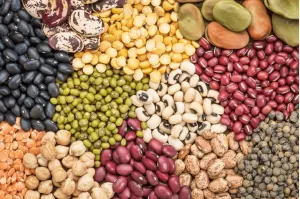Beans: The Versatile Crown Jewel of Global Cuisine
A Tasty Journey Through the Varieties and Nutritional Virtues of Beans
Introduction
Nutritious, versatile, and universally beloved, beans are an ingredient that transcends culinary borders, serving as the foundation for traditional dishes around the world. This article pays homage to this humble, yet powerful, grain, exploring its history, varieties, and immense contribution to human nutrition.
Origins and History
Beans are among the oldest cultivated foods, with records of their cultivation dating back thousands of years in the Americas, Africa, and Asia. This grain was a fundamental part of the diet of many ancient civilizations, including the Mayans and Aztecs, who valued beans for their ability to fix nitrogen in the soil and for their sustainable combination with other staples like corn and squash.

Varieties and Culinary Characteristics
Red Beans: Known for their firm texture and slightly sweet flavor, red beans are a key ingredient in dishes such as chili and Indian rajma.
White Beans: With a creamy texture, white beans are widely used in Italian and French cuisine, being essential for cassoulet and minestrone.
Black-eyed Peas (Cowpeas): A grain with a mild flavor and soft texture, popular in the southern United States and throughout Brazil, especially in dishes like baião de dois.
Pinto Beans: Often found in Mexican and Southwestern American cuisine, pinto beans are valued for their speckled skin that remains firm after cooking.
Black Beans: Rich in antioxidants and with a strong, earthy flavor, black beans are a staple of Latin American and Caribbean cuisine, ideal for feijoada, soups, and as filling for burritos and tacos. Black beans, perhaps the most iconic, are the star of the feijoada, the national dish that brings family and friends together around a hearty table. Originating from South America, they are appreciated for their firm skin that maintains the integrity of the grain even after cooking, providing a robust texture and a rich, aromatic broth.
Carioca Beans: In contrast, carioca beans, with their distinctive stripes, are the most consumed variety in the country. Versatile and quick-cooking, they are the perfect accompaniment to rice in everyday meals, creating the classic “rice and beans.” Their mildness allows them to be combined with a myriad of ingredients, adapting to various palates and recipes.
Fradinho Beans: Not least is the fradinho bean, central to dishes like acarajé and baião de dois. With its mild flavor and granular texture, it is a vehicle for the spices and flavors with which it is cooked, absorbing and complementing the seasonings of each recipe.
Cranberry Beans: Cranberry beans, with their pinkish spots and distinctive flavor, are often chosen for soups and regional feijoadas, where their ability to absorb flavors makes them a key ingredient for dishes with personality.
Jalo Beans: Jalo beans, with their sweet flavor and soft texture, are often used in salads and cold dishes, being a favorite for those who prefer a less dominant bean in the dish, but still flavorful and satisfying.
Nutritional Value
Beans are a nutritional powerhouse. Rich in protein, fiber, iron, magnesium, and a range of B vitamins, they are an excellent meat substitute for vegetarians and vegans. Moreover, their low fat content and ability to control blood sugar levels make beans an ally in weight management and the prevention of chronic diseases.
Cultural and Economic Impact
Beans are not just food; they are a cultural currency, playing a crucial role in festivals, traditions, and sustainable agriculture. Due to their ability to enhance soil fertility, beans are often incorporated into crop rotation systems, promoting more ecological agricultural practices.
Conclusion
From a simple grain to a pillar of food sustainability, beans rightfully occupy their place as an icon of global cuisine. In their numerous varieties, each type of bean offers a window into the culinary traditions and innovations of cultures around the world. As we embrace the diversity of flavors and nutritional benefits that beans have to offer, we continue the millennia-old tradition of nourishing our bodies and enriching our culinary heritage.
Each type of bean in Brazil carries with it a story, a geography, and a culture. They are more than mere components of a recipe; they are storytellers, transporting those who taste them to the different landscapes and communities of Brazil.
By cooking with Brazilian beans, we not only nourish the body but also honor the heritage of a country where food is celebrated as an expression of identity and joy.